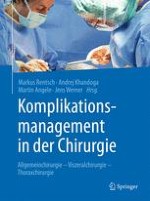Zusammenfassung
Die Mehrzahl der Patienten, bei denen eine Ösophagusresektion durchgeführt wird, wird aufgrund einer malignen Erkrankung operiert. Dieses Patientenkollektiv ist charakterisiert durch eine große Anzahl an Komorbiditäten, die einen erheblichen Einfluss auf den postoperativen Verlauf haben. Bei Adenokarzinomen sind eine begleitende Adipositas und kardiovaskuläre Vorerkrankungen führend, während bei Plattenepithelkarzinomen häufig die Folgen eines Alkohol- und Nikotinabusus zu beobachten sind. Zusätzlich scheint eine neoadjuvant durchgeführte Chemo- oder Radiochemotherapie die postoperative Komplikationsrate zu erhöhen. Schließlich führt auch die Tatsache, dass die Ösophaguschirurgie immer sowohl das Abdomen als auch den Thorax betrifft, zu einer Erhöhung des Operationsrisikos. Demgegenüber ist das operative Risiko in der Magenchirurgie grundsätzlich geringer einzuschätzen. Doch auch hier gibt es spezifische Komplikationsmöglichkeiten, die in diesem Kapitel dargestellt werden sollen.











